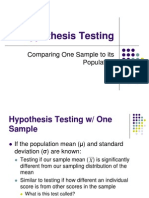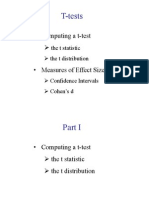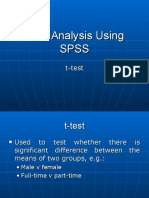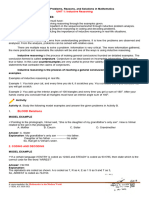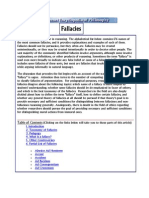One Sample Parametric Tests: Unit IV: Statistical Procedures
One Sample Parametric Tests: Unit IV: Statistical Procedures
Uploaded by
1ab4cCopyright:
Available Formats
One Sample Parametric Tests: Unit IV: Statistical Procedures
One Sample Parametric Tests: Unit IV: Statistical Procedures
Uploaded by
1ab4cOriginal Title
Copyright
Available Formats
Share this document
Did you find this document useful?
Is this content inappropriate?
Copyright:
Available Formats
One Sample Parametric Tests: Unit IV: Statistical Procedures
One Sample Parametric Tests: Unit IV: Statistical Procedures
Uploaded by
1ab4cCopyright:
Available Formats
Chapter 19
One Sample Tests: z- and t-
Unit IV: Statistical Procedures
19
One Sample Parametric Tests
The One-Sample z-Test The One-Sample t-Test The Confidence Interval
Dr. Roberta Damon developed a marital profile of Southern Baptist missionaries in eastern South America in 1985. Part of her study involved measuring whether SBC missionary husband-wife pairs differed from American society-at-large on the variable Couple Agreement on Religious Orientation, as measured by the Religious Orientation Test. She set = 0.01 and decided to use a two-tail test. The American mean () at the time was 56. The mean score ( ) and estimated standard deviation (s) of her sample of 330 missionaries was 86.3 and 20.847 respectively. Applying the sampling distribution z-formula we introduced on page 17-9, she computed z as follows:
Remember that a two-tail test (=0.01) requires only z=2.58 for declaring a difference significant. Here we see z=26.403. Southern Baptist missionaries serving in eastern South America in 1984, as a group, scored over 26 standard errors above the national mean in Couple Agreement1 on the Religious Orientation Scale! In chapters 17 and 18 we explored the theoretical basis for hypothesis testing with sample means. Here in Chapter 19 we will use these principles to establish our first practical use for hypothesis testing. One-sample tests compare a population mean () with a single sample mean( ). We have already seen the one-sample z-test in action. We will also discuss the one-sample t-test.
The One-Sample z-Test
The procedure we used in chapter 17 to compute the significance of a church's attitude toward building renovation, as well as in the analysis shown above, used the one-sample z-test. The formula has two forms. When the population standard deviation () is known, we use the equation on the left below. When sigma () is not known
Couple Agreementmeasures the degree to which religion serves as a relationship strength. A high score means that there is high agreement on religious issues between husbands and wives, and that subjects consider religion an important part of their marriage relationship. Roberta McBride Damon, A Marital Profile of Southern Baptist Missionaries in Eastern South America, (Fort Worth, Texas: Southwestern Baptist Theological Seminary, 1985), 37
1
4th ed. 2006 Dr. Rick Yount
19-1
Research Design and Statistical Analysis in Christian Ministry
IV: Statistical Procedures
(which is usually the case), we use s to estimate , and so use the equation on the right (the more popular of the two).
The limitation to using s to estimate is whether the sample is large enough to approximate a normal curve. "Large enough" means at least n=30 subjects. The normal curve table (z-) requires a normal distribution of scores in order to give accurate proportions under the curve. When a sample contains less than 30 scores, the requirement of normality is not met, and we cannot use the normal curve table or the z-test. In this case, use the one sample t-test.
The One-Sample t-Test
The one-sample t-test must be used to test the difference between a population mean () with a single sample mean( ) when both (1) the population standard deviation () is unknown, and (2) the sample size (n) is less than 30 (That is, the z-test cannot be used under these conditions). However, note that the one-sample t-test can be used for samples of any size, and is often used instead of the z-test, making it a one of the most popular tests of difference. The value of the one-sample t is obtained exactly like the one-sample z. The formula looks just like the z-test formula given earlier:
The logic behind the one-sample t is the same as we've used for the z-test, with one exception. A smaller n means lower power (see 18-5). Since the t-test is designed to be used with smaller n samples, the t-distribution critical value table assigns a slightly larger critical value to reflect the loss of power.
The t-Distribution Table
Look at the t-distribution table in appendix A3-2 at the back of the text. Notice that the column headings reflect levels of significance ranging from 0.10 to 0.005. These are one-tailed probabilities. The heading df on the left bold-faced column is an abbreviation for degrees of freedom. Degrees of freedom is directly related to the size of a sample, but it is a concept that is much easier to illustrate than define. Lets say we have three variables that add to 10, such that X + Y + Z = 10. What number can we substitute for "X"? The answer is any number. The variable X is free to vary. We have one degree of freedom. So let's arbitrarily assign the value "2" to X. We now have 2 + Y + Z = 10. What number can we substitute for "Y"? The answer is any number. Variable Y is free to vary. We now have two degrees of freedom. Let's assign the value "5" to Y. We now have 2 + 5 + Z = 10. What number can we substitute for "Z"? There is only one number in the universe: Z must equal "3" for the equation to be true. Z is NOT free to vary. So for X, Y, and Z, three numbers (n=3), we have two (n-1) degrees of freedom. This relationship holds true for any size n: df = n-1. Or in English, if you
19-2
4th ed. 2006 Dr. Rick Yount
Chapter 19
One Sample Tests: z- and t-
have 26 subjects in a study and use the one-sample t-test, then the degrees of freedom for the analysis is (n-1 = 26-1 =) 25. Recall that in the Normal Curve table we can find proportion values for any zscore. We focused on the four primary critical values of 1.65, 1.96, 2.33, and 2.58, but could calculate proportions for any z from 0 to 3. Look at the t-table under the column labelled 0.05 and move down to the bottom of the column, next to df= . The value of the t-test critical value (1.645) is exactly the same as the value in the Normal Curve table (0.05, 1-tail test). To the right of 1.645 is the .025 column with the value "1.96." This is exactly the same as the 2tail 0.05 Normal Curve value of z. The heading ".025" in the t-table refers to the /2 area of the two-tail test: 0.05/2 = 0.025. The next value to the right is "2.326," the one-tail 0.01 value of z. And the next, "2.576." These are the same four essential critical values we studied for the normal curve: 1.65, 1.96, 2.33, and 2.58. The t-Distribution table differs from the Normal Curve table in that it contains nothing but critical values for a given level of significance and df. Each df row provides the critical value for a unique t-distribution. As we have just seen, for , the t-distribution is the same as the Normal Curve distribution. As n decreases, the t-distribution becomes increasingly platykurtic. That is, the smaller the sample size, the flatter and wider the distribution. This pushes the critical values out farther on the tails, making significance harder to establish, as you can see in the diagram at right. Now choose the column in the t-table ending with "1.645." Move up the column and watch how the critical values increase. As df decreases, critical values increase. This is just another way of saying as n decreases, power decreases. Thus, the t-table accounts for lower power which derives from smaller n.
Computing t
Let's revisit the congregation study of attitude toward building renovation we did with the z-test in Chapter 17. Suppose our random sample is a small one, made up of only 25 members rather than 100. Lets use the same hypothesized population value of 4.0 and the same mean and standard deviation of 3.8 and 0.7 respectively. Computing t we have
The critical value for =.05, 1-tail, and df = 24 is 1.711. Notice that this critical value for t, symbolized as tcv, is a larger value than the comparable z-test value of 1.65. But since our value of -1.43 is smaller (not as far out on the left tail) than -1.711 , we retain the null hypothesis. While the difference between sample mean and hypothesized population mean is the same as before (-0.2), the standard error of the mean (sx) was twice as large -- 0.14 in the t-test as opposed to 0.07 in the z-test. This is due to the smaller number of subjects (n=25) in this sample as compared to the former one (n=100). Additionally, the critical value bar for the t-test (1.711) is higher than the z-test (1.645). So the smaller sample size yields less power. The same hypothesis (H0:=4.0)
4th ed. 2006 Dr. Rick Yount
19-3
Research Design and Statistical Analysis in Christian Ministry
IV: Statistical Procedures
and the same difference (-0.2) yielded two different results. The z-test yielded a significant difference. The t-test did not. Why? Because in the second case we lacked sufficient power to declare the difference significant. The t-test does not correct for lack of power. It simply allows us to test samples too small for the z-test. Up to now we have used the z- and t- formulas to test single hypotheses. Another, less common, use for these formulas is in the creation of a confidence interval.
Confidence Intervals
The confidence interval offers another approach to making statistical decisions. In this approach, we set an interval around the population mean, bordered by confidence limits. We can then state, with a given degree of confidence, that the null hypothesis is true if any sample mean which falls within this interval , and false if it falls outside this interval. The benefit of using a confidence interval is that any number of sample means can be tested with only one computation.
A z-Score Confidence Interval
The z-score confidence interval equation looks like this:
where CI95 is the 95% confidence interval consisting of two endpoint values (x.x, x.x), is the population mean, z is the z-score for the given level of significance (in this case, = 0.05, so z = 1.96), and is the standard error of the mean. Now let's revisit the church attitude study again using n=100 subjects and a confidence interval based on the z-score. Using the formula above we have the following computation:
In the diagram at left you can see the church's mean score (n=100) of 3.8, and the confidence interval values of 3.863 and 4.137. The mean (3.8) falls outside the confidence interval. We therefore reject the null hypothesis (just as we did with the hypothesis test in Chapter 17). The church has a negative attitude toward renovation. But let's assume we tested twenty churches in our association.2 All we need do is calculate the mean score of each church and compare that to the interval "3.863 - 4.137." Any church mean falling below this interval
I've oversimplified this to focus your attention on the meaning of confidence interval. But for this to actually work as I've described it, we have to assume that all twenty churches produced the same standard deviation (s) on their attitude scores -- and this is an unreasonable assumption. If we were to actually do this study, we would compute the overall standard deviation from all twenty churches, and use that value to construct the confidence interval. Then, any church falling outside the interval would be significantly different from 4.00, the hypothesis neutral point. But even so, we make one computation, 20 comparisons.
2
19-4
4th ed. 2006 Dr. Rick Yount
Chapter 19
One Sample Tests: z- and t-
reflects a significant negative attitude. Any church mean falling above the interval reflects a significant positive attitude. Any mean falling within the interval reflects no attitude (neutral). Confidence intervals are always based on two-tailed tests. The two values, 3.863 and 4.137, are called the confidence limits. The range of scores between the limits, shown at right by the two-headed arrow, is the confidence interval.
A t-Score Confidence Interval
We can also develop a confidence interval with t-scores. We simply substitute the appropriate tcv value for zcv. In the above example, the appropriate t-table critical value (0.05, 2-tail, df=24) is 2.064. The standard error of the mean is different because of the change in sample size (25 vs. 100). It is 0.14 rather than 0.07, which we used with the z-test (note the equation in the middle of page 19-3). Therefore, the t-value confidence interval equation is
The flatter curve of the t-distribution forces the interval to be wider than the one we computed with z. Because of the larger standard error of the mean ( ), the t-score cut-off values are farther apart (0.14 vs. 0.07). Notice also that the sample mean of 3.8, which fell outside the z-score interval, falls inside the t-score confidence interval. This agrees with the hypothesis test on page 19-3. Since the mean of 3.8 falls within the confidence interval, it is declared not significantly different. The different result (z- vs. t-) is due directly to different n's (100 subjects vs. 25 subjects). The loss of power with n=25 changed our significant finding to a non-significant finding.
Summary
This chapter is built on Chapters 17 and 18. The principal extensions we made in this chapter include the use of the t-distribution table, the concept of degrees of freedom and confidence interval. The next chapter extends these concepts still further: to testing mean differences between two samples.
Vocabulary
Confidence interval Degrees of freedom One sample z-test One sample t-test Distance between the 2-tail critical values centered on mean. "Region of acceptance (of null)" the number of values free to vary given a fixed sum (n-1 for one group) tests difference between and X-bar - if is known, or if is unknown and n>30 tests difference between and X-bar - if unknown and estimated by s (must use if n<30)
Remember: The one-sample t-test can be used with any sample size, which makes it one of the most popular statistics of difference.
4th ed. 2006 Dr. Rick Yount
19-5
Research Design and Statistical Analysis in Christian Ministry
IV: Statistical Procedures
Study Questions
1. A sample mean on an attitude scale equals 3.3 with a standard deviation of 0.5. There were 16 people tested in the group. Test the hypothesis: The group will score significantly higher than 3.0 on attitude X. (Use =0.01) A. State the statistical hypothesis. B. Compute the proper statistic to answer the question. (con't) C. Test the statistic with the appropriate table. D. State your conclusion. E. Establish a 99% confidence interval about the sample mean. (Careful here...) F. Draw the sampling distribution and the confidence interval. 2. Repeat #1 above, but with a sample size of 49. 3. A study in 1980 revealed that the average salary of Southern Baptist ministers of education in Fort Worth was $29,000 (fictitious data). You randomly sample 28 ministers of education (1995) and find their average salary is $37,000 with a standard deviation of $3,000. Have salaries improved significantly? A. B. C. D. E. F. G. Draw and label an appropriate sampling distribution. State the research hypothesis. State the statistical hypothesis. Select the proper test and compute the statistic. Test the statistic with the appropriate table. Establish a 95% confidence interval about the sample mean. Does this confidence interval agree with your hypothesis test? Explain how.
Sample Test Questions
1. When must you use the one-sample t-test to test differences between two groups of scores? A. When you do not know and n<30. B. When you do not know . C. When you know and n>30. D. When you do not know s and n<30. 2. The denominator of the one-sample t-test equals A. n-1 B. s//n C. D. s 3. What would be your best estimate of the critical value for t (.05, df=19, 1-tail)? A. 1.65 B. 1.73 C. 1.96 D. 2.01 4. T F A confidence interval produced by a z-score is narrower than one produced by a tscore particularly for samples of 30 or fewer subjects. 5. T F If a confidence interval, centered at the hypothesized population mean, includes a sample mean, then the sample mean is considered significantly different.
19-6
4th ed. 2006 Dr. Rick Yount
You might also like
- WEEK 8 Percentiles and T DistributionDocument6 pagesWEEK 8 Percentiles and T DistributionCresilda Mugot100% (1)
- T DistributionDocument4 pagesT DistributionEr Rajesh BuraNo ratings yet
- Manure AnalysisDocument62 pagesManure Analysis1ab4cNo ratings yet
- Argumentation Methods For Artificial Intelligence in LawDocument283 pagesArgumentation Methods For Artificial Intelligence in LawJUAN FRANCISCO CABEZAS MARTINEZ100% (1)
- Methods of Teaching: M.Vijayalakshmi Assistant ProfessorDocument61 pagesMethods of Teaching: M.Vijayalakshmi Assistant ProfessorT Hari Prasad100% (2)
- Lesson 23: Tests of Hypotheses - Small SamplesDocument5 pagesLesson 23: Tests of Hypotheses - Small SamplesWinny Shiru MachiraNo ratings yet
- 20 Twosamp 4thDocument12 pages20 Twosamp 4thPunita RaniNo ratings yet
- Z Test FormulaDocument6 pagesZ Test FormulaE-m FunaNo ratings yet
- Mann - Whitney Test - Nonparametric T TestDocument18 pagesMann - Whitney Test - Nonparametric T TestMahiraNo ratings yet
- 123 T F Z Chi Test 2Document5 pages123 T F Z Chi Test 2izzyguyNo ratings yet
- Assignment Updated 101Document24 pagesAssignment Updated 101Lovely Posion100% (1)
- Stats 2 Module UpdatedDocument33 pagesStats 2 Module Updatednandgaonkarmahesh041No ratings yet
- An Introduction To T-Tests: Statistical Test Means Hypothesis TestingDocument8 pagesAn Introduction To T-Tests: Statistical Test Means Hypothesis Testingshivani100% (1)
- CLG Project ReportDocument13 pagesCLG Project Reportruchi sharmaNo ratings yet
- Student's T TestDocument7 pagesStudent's T TestLedesma Ray100% (1)
- Notes 515 Fall 10 Chap 6Document12 pagesNotes 515 Fall 10 Chap 6Sultana RajaNo ratings yet
- StaticsticsDocument2 pagesStaticsticsCaesar GarsiyaNo ratings yet
- Common Statistical TestsDocument12 pagesCommon Statistical TestsshanumanuranuNo ratings yet
- One Sample Hypothesis TestingDocument29 pagesOne Sample Hypothesis TestingAnastasiaNo ratings yet
- T TESTDocument5 pagesT TESTMeenalochini kannanNo ratings yet
- UNIT IV NewDocument71 pagesUNIT IV Newmsvimal07No ratings yet
- Basic Anova PDFDocument6 pagesBasic Anova PDFEmmanuel Jimenez-Bacud, CSE-Professional,BA-MA Pol SciNo ratings yet
- Regression AnalysisDocument68 pagesRegression AnalysisTewabeNo ratings yet
- Related Topics/headings: Categorical Data Analysis Or, Nonparametric Statistics Or, Chi-SquareDocument17 pagesRelated Topics/headings: Categorical Data Analysis Or, Nonparametric Statistics Or, Chi-Squarebt2014No ratings yet
- Student S T Statistic: Test For Equality of Two Means Test For Value of A Single MeanDocument35 pagesStudent S T Statistic: Test For Equality of Two Means Test For Value of A Single MeanAmaal GhaziNo ratings yet
- Lilliefors Van Soest's Test of NormalityDocument10 pagesLilliefors Van Soest's Test of Normalitydimitri_deliyianniNo ratings yet
- T-Tests: - Computing A T-TestDocument38 pagesT-Tests: - Computing A T-TestFrazButtNo ratings yet
- Science and TechnologyDocument16 pagesScience and TechnologyAnn Jaleen CatuNo ratings yet
- Statistics & Probability Q4 - Week 3-4Document16 pagesStatistics & Probability Q4 - Week 3-4Rayezeus Jaiden Del RosarioNo ratings yet
- Bernard F Dela Vega PH 1-1Document5 pagesBernard F Dela Vega PH 1-1BernardFranciscoDelaVegaNo ratings yet
- S2 - Q4l9statppt10Document110 pagesS2 - Q4l9statppt10Shereen Grace GaniboNo ratings yet
- Hypothesis TestingDocument44 pagesHypothesis Testinganpyaa100% (1)
- Costructs T Distribution (Dianne)Document9 pagesCostructs T Distribution (Dianne)Dianne RuizNo ratings yet
- Percentile and The T-Distribution: Melc Competency CodeDocument8 pagesPercentile and The T-Distribution: Melc Competency CodeErnie LahaylahayNo ratings yet
- Week 7: The T Distribution, Confidence Intervals and TestsDocument51 pagesWeek 7: The T Distribution, Confidence Intervals and TestsHussein RazaqNo ratings yet
- 05 Statistical Inference-2 PDFDocument14 pages05 Statistical Inference-2 PDFRama DulceNo ratings yet
- ML Unit2 SimpleLinearRegression pdf-60-97Document38 pagesML Unit2 SimpleLinearRegression pdf-60-97Deepali KoiralaNo ratings yet
- Unit+16 T TestDocument35 pagesUnit+16 T Testmathurakshay99No ratings yet
- Kendall TauDocument8 pagesKendall TauZenzen MiclatNo ratings yet
- Day 13 - Intro To T StatisticDocument7 pagesDay 13 - Intro To T StatisticLianne SedurifaNo ratings yet
- Where Are We and Where Are We Going?: Purpose IV DV Inferential TestDocument36 pagesWhere Are We and Where Are We Going?: Purpose IV DV Inferential TestNassir CeellaabeNo ratings yet
- CramerDocument7 pagesCramerSathish KumarNo ratings yet
- T (Ea) For TwoDocument31 pagesT (Ea) For Twobszool006No ratings yet
- Rank Biserial CorrelationDocument3 pagesRank Biserial Correlationryanosleep100% (1)
- Estimation of Population MeanDocument14 pagesEstimation of Population MeanAmartyaNo ratings yet
- Ciadmin, Journal Manager, 1704-6756-1-CEDocument10 pagesCiadmin, Journal Manager, 1704-6756-1-CEvasuNo ratings yet
- 102 02 AnswersDocument17 pages102 02 AnswersmanojNo ratings yet
- Chi-Square Tests PDFDocument9 pagesChi-Square Tests PDFscjofyWFawlroa2r06YFVabfbajNo ratings yet
- PS 601 Notes - Part II Statistical TestsDocument56 pagesPS 601 Notes - Part II Statistical TestsAnisah NiesNo ratings yet
- Research Iii: Quarter 3 Week 3Document21 pagesResearch Iii: Quarter 3 Week 3John Miles SerneoNo ratings yet
- The T DistributionDocument5 pagesThe T DistributionSoftkillerNo ratings yet
- Compare Means: 1-One Sample T TestDocument18 pagesCompare Means: 1-One Sample T Testbzhar osmanNo ratings yet
- Some Basic Null Hypothesis TestsDocument19 pagesSome Basic Null Hypothesis TestsSudhir JainNo ratings yet
- Pearson R Correlation: TestDocument5 pagesPearson R Correlation: TestRichelle IgnacioNo ratings yet
- GROUP - 9 - T-Distribution and PercentileDocument45 pagesGROUP - 9 - T-Distribution and PercentileEditorialranged CartoonistoplaneNo ratings yet
- Comparing Groups (ANOVA)Document56 pagesComparing Groups (ANOVA)IraNo ratings yet
- Methods GuideDocument16 pagesMethods GuideBrigitta DomokosNo ratings yet
- Solution 1Document14 pagesSolution 1Mahesh JainNo ratings yet
- Stat LAS 2024Document3 pagesStat LAS 2024umorherlatipNo ratings yet
- Evaluation of Genetic Diversity and Agronomic Traits of Germplasm Resources of Stropharia RugosoannulataDocument16 pagesEvaluation of Genetic Diversity and Agronomic Traits of Germplasm Resources of Stropharia Rugosoannulata1ab4cNo ratings yet
- Soil - Gypsum As An Agricultural Amendment General Use GuidelinesDocument36 pagesSoil - Gypsum As An Agricultural Amendment General Use Guidelines1ab4cNo ratings yet
- Wet Digestion - Pequerul Et Al 1993Document5 pagesWet Digestion - Pequerul Et Al 19931ab4cNo ratings yet
- Effects of Light Intensity and Photoperiod On Morphological Development and Photosynthetic Characteristics of CorianderDocument18 pagesEffects of Light Intensity and Photoperiod On Morphological Development and Photosynthetic Characteristics of Coriander1ab4cNo ratings yet
- Influence and Role of Fungi, Bacteria, and Mixed Microbial Populations On Phosphorus Acquisition in PlantsDocument24 pagesInfluence and Role of Fungi, Bacteria, and Mixed Microbial Populations On Phosphorus Acquisition in Plants1ab4cNo ratings yet
- Laboratory Extractions of Soil Phosphorus Do Not Reflect The Fact That Liming Increases Rye Phosphorus Content and Yield in An Acidic SoilDocument18 pagesLaboratory Extractions of Soil Phosphorus Do Not Reflect The Fact That Liming Increases Rye Phosphorus Content and Yield in An Acidic Soil1ab4cNo ratings yet
- Analise de Solo1Document12 pagesAnalise de Solo1ViniciusMacedoNo ratings yet
- The Normal Curve Error Rates and PowerDocument8 pagesThe Normal Curve Error Rates and Power1ab4cNo ratings yet
- Partial Defoliation of Vitis Vinifera L. Cv. Cabernet SauvignonDocument9 pagesPartial Defoliation of Vitis Vinifera L. Cv. Cabernet Sauvignon1ab4cNo ratings yet
- Basic Math Skills: Unit III: Statistical FundamentalsDocument6 pagesBasic Math Skills: Unit III: Statistical Fundamentals1ab4cNo ratings yet
- 13 Experiment 4thDocument12 pages13 Experiment 4th1ab4cNo ratings yet
- Week 4 Deductive Validity - Inductive Strength Deductive ValidityDocument5 pagesWeek 4 Deductive Validity - Inductive Strength Deductive ValidityBảo TuấnNo ratings yet
- Inferential StatisticsDocument28 pagesInferential Statisticsadityadhiman100% (3)
- Week 8: Inferential Statistics: Test of IndependenceDocument4 pagesWeek 8: Inferential Statistics: Test of IndependenceKezia MadeloNo ratings yet
- Sample Problems NonparaDocument7 pagesSample Problems NonparaRhia Mae TeporaNo ratings yet
- Influenţa Coeziunii Şi Structurii Grupului Asupra Performanţei Şi Calităţii Activităţii În MuncăDocument18 pagesInfluenţa Coeziunii Şi Structurii Grupului Asupra Performanţei Şi Calităţii Activităţii În MuncăSimonaDavidNo ratings yet
- Stat - Lesson 12 ANOVADocument9 pagesStat - Lesson 12 ANOVAChed PerezNo ratings yet
- Logic: Prepared By: Ruzanna Abdul ShukorDocument42 pagesLogic: Prepared By: Ruzanna Abdul ShukorSiang ElsonNo ratings yet
- Analyze The E-Views Report: R Var ( Y) Var (Y) Ess Tss Var (E) Var (Y) Rss Nvar (Y) R RDocument5 pagesAnalyze The E-Views Report: R Var ( Y) Var (Y) Ess Tss Var (E) Var (Y) Rss Nvar (Y) R REmiraslan MhrrovNo ratings yet
- Chapter 8 - Trendlines and Regression AnalysisDocument67 pagesChapter 8 - Trendlines and Regression AnalysisRachel BrenerNo ratings yet
- L23 - Hypothesis Testing ExamplesDocument24 pagesL23 - Hypothesis Testing Examplesquang hoaNo ratings yet
- Hypothesis Testing 1 PDFDocument15 pagesHypothesis Testing 1 PDFMaQsud AhMad SaNdhuNo ratings yet
- 8614 - Assignment 2 Solved (AG)Document19 pages8614 - Assignment 2 Solved (AG)Maria GillaniNo ratings yet
- Data Analysis Using Spss T Test 1224391361027694 8Document24 pagesData Analysis Using Spss T Test 1224391361027694 8Rahman SurkhyNo ratings yet
- Supporting Sentences - Practice 2Document15 pagesSupporting Sentences - Practice 2030439230061No ratings yet
- ML Causality Day-2Document12 pagesML Causality Day-2marta bernardiNo ratings yet
- T-Tests, Anovas & Regression: and Their Application To The Statistical Analysis of NeuroimagingDocument39 pagesT-Tests, Anovas & Regression: and Their Application To The Statistical Analysis of NeuroimagingWork PlaceNo ratings yet
- BUSINESS STATISTICS: Simple Linear Regression and CorrelationDocument55 pagesBUSINESS STATISTICS: Simple Linear Regression and CorrelationLaurence Rue AudineNo ratings yet
- Gec 104 Final Module 3Document9 pagesGec 104 Final Module 3Danica Marie RegaladoNo ratings yet
- Maintenace Strategy PDFDocument66 pagesMaintenace Strategy PDFhuse100% (1)
- Spss Tutorials: One-Way AnovaDocument12 pagesSpss Tutorials: One-Way AnovaMat3xNo ratings yet
- 5 - 7. MR - EstimationDocument12 pages5 - 7. MR - EstimationNikhilesh JoshiNo ratings yet
- Assignment 2Document22 pagesAssignment 2Nurul Absar RashedNo ratings yet
- Week 10Document42 pagesWeek 10Jerry maNo ratings yet
- FallaciesDocument54 pagesFallaciesIWantToBelieve8728100% (5)
- Recursive - and - Non - Recursive - Models - LectureDocument14 pagesRecursive - and - Non - Recursive - Models - LectureTram AnhNo ratings yet
- Cheat Sheet FDocument2 pagesCheat Sheet FFrancis TanNo ratings yet
- One Way AnovaDocument5 pagesOne Way AnovaRic John Naquila CabilanNo ratings yet


















